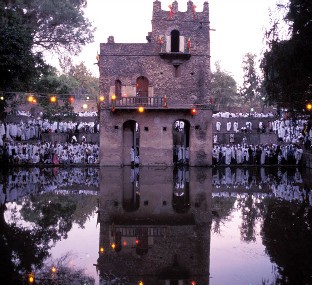The three days of Timkat
For many early Christians, only at the moment of Jesus' baptism was he suddenly overwhelmed by the power of divinity.

May I wish you all a happy and blessed Timkat season. Timkat, I should explain, is an important festival of the 40-million-strong Orthodox Church of Ethiopia. By common consent, it is one of the world's most spectacular religious festivals. A three-day celebration literally brings large areas of the country to a halt in a season dedicated to elaborate rituals, to feasting and gift giving, pageantry and mysticism. In vast pilgrimages and processions, individual churches parade their tabots —symbols of the Ark of the Covenant.
But what are Ethiopians celebrating so passionately? Timkat comes 12 days after Christmas, which in the local calendar means that it falls on January 17 through 19. Tourist guidebooks vaguely relate it to Epiphany. Actually, the event commemorates the baptism of Christ in the Jordan (Timkat is the Amharic word for baptism). Baptismal symbolism dominates the rituals to the point that enthusiastic believers plunge into consecrated pools to renew their vows. The baptismal theme recalls some very early debates in the Christian church, controversies that were raging not long after apostolic times. Timkat is, in fact, a startling relic of ancient Christian beliefs.
Read our latest issue or browse back issues.
Churches around the world naturally make much of the Christmas season that marks the manifestation of God's glory in the world, but they vary greatly on the limits of the season and its exact meaning. For many Western Christians, the focus of the celebration tends to be not the actual birth but Epiphany and the visit of the Magi. Christians in the Orthodox tradition, however, link Epiphany to Christ's baptism in the Jordan.
In the first three Christian centuries, believers had very different ideas about the divinity of Christ and whether there was a particular moment at which he gained that status. Yes, Christ came into the world—but when exactly did that divinity shine forth?
The mainstream church believed, of course, that the baby born in Bethlehem was God incarnate, but powerful voices held rival views. For many early Christians, Jesus was a good or holy man, conceived and born in the usual way, and only at the moment of his baptism was he suddenly overwhelmed by the power of divinity, the Logos or Holy Spirit.
That understanding easily arises if one reads just the Gospels of Mark and John, without considering the birth stories of Matthew and Luke. Both Mark and John begin their narratives with the story of John the Baptist, followed by Jesus' baptism, when some extraordinary power seems to descend on him. At that point, Jesus flees into the wilderness, presumably to confront the astonishing new reality he has encountered. This is also the sequence of events in the lost gospel source called Q. Early in the second century, the influential thinker Cerinthus popularized the idea of Jesus being possessed and overwhelmed by a divine force at his baptism, and that became the standard gnostic view, which the larger church considered a gross heresy.
Yet the mainstream church never forgot its ancient fascination with Christ's baptism. Historians have long debated exactly why churches celebrate Christmas at midwinter. They usually link it to the Roman Saturnalia festival. But other agendas were at work. We know that late in the second century gnostic followers of the brilliant Alexandrian Basilides had a special veneration for Jesus' baptism, which they celebrated on January 6. This was the date at which God became manifest (to use the Greek word, it was the time of epiphany). The mainstream church appropriated the festival easily enough, as the lines between orthodoxy and heresy were not strictly defined in Egypt at this time. The baptism theme does not fit logically with the standard Christmas story that we know—most obviously, some 30 years separated birth and baptism—but such considerations did not prevent Egyptians from accommodating what might otherwise be seen as two irreconcilable views of Christ's appearance.
In light of those origins, let us look again at the Ethiopian Timkat. Although most of the church's earliest records have been lost, we know that Ethiopian Christianity was flourishing by the fourth century and that it had a very close relationship with the church in Egypt, especially Alexandria. Not surprisingly, then, Ethiopia keeps alive very early Egyptian interests and obsessions, even some that might have been forgotten in Egypt itself. Whatever the church's official theology says, Timkat recalls a very old and somewhat heretical interpretation of Christ's baptism and its significance.
If you want to see Timkat at its most spectacular, go to the celebrations in Ethiopia's royal city of Gondar. Gondar, by the way, was built in the 17th century by a great emperor who bore the auspicious name of Basilides.






